Article reproduced with kind permission of Mike Fishwick
Even those who keep their cars in top condition often ignore their battery until it dies. This failure is usually regarded with surprise, and accepted as being ‘One of those things,’ but at £60 to £80 a time it is an expensive folly.

Typical BMW Battery – Z3
Normal Maintenance
If your battery is not a sealed zero-maintenance type, it needs a check on the cell levels at least twice a year, and topping up with de-mineralised water – as is used in steam irons etc. This compensates for loss of the water in the dilute sulphuric acid electrolyte being turned into bubbles of oxygen and hydrogen by the charging current, a process known as ‘gassing.’
During winter, do not top up your battery and leave it, as the water will lie on top of the denser electrolyte, and may freeze. Top up before driving, when normal charging will mix the water and acid.
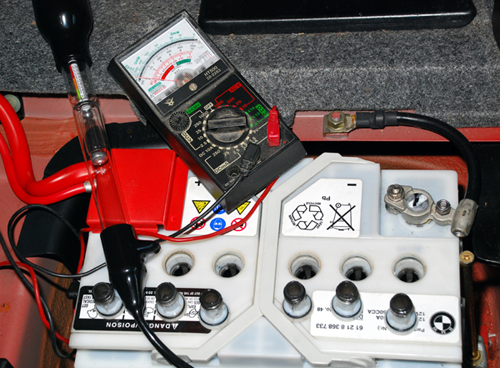
Normal maintenance equipment in action
Even low-maintenance batteries, in which the use of lead-calcium plates promotes less ‘gassing’ and loss of water from the electrolyte, still require an occasional check. A strip of adhesive tape across the plugs – even if it has a BMW logo – does not denote a ‘sealed’ battery, being simply a sign that the battery has not been checked since it was built.
Measure the battery voltage some hours after charging, or a decent run, when 12.5 to 13 volts should be found. If in doubt, check your meter against a known good instrument, and do not regard digital meters as being inherently accurate. Your car’s alternator should maintain 13.5 to 14.4 volts with a fully-charged battery.
Also take hydrometer readings of each cell. With a fully-charged battery these should read between 1275 and 1300 (the specific gravity, or density, when compared to distilled water at 1000). If your battery is under the bonnet, the readings will be lower when hot, but a single lower reading indicates a dying cell. Suitable hydrometers are readily available from Halfords etc. and are also handy for topping up the cells.
Remember that the dilute sulphuric acid used in batteries is corrosive, so try not to drip it on clothing or bodywork, as before long it will eat through. Needless to say, contact with skin or eyes is to be avoided. Treat any spillages with a strong bicarbonate of soda solution, and rinse copiously.
The more modern batteries really are sealed, and use a chemical process to convert the gases formed during charging back into dilute sulphuric acid again. They – as with any other battery – only ask to be protected from extremes of heat and cold, or fully discharged.
Occasionally remove and clean the battery terminals, lightly coating them with Vaseline before reassembly. Do not forget the engine earth strap, which is usually bolted to the aluminium of the offside engine mounting. Corroded aluminium makes a wonderful insulator, and in some circumstances a failed engine earth can destroy the engine’s electronics. In many cases the earthing lugs are crimped around their flexible copper straps, which can set up considerable resistance once corrosion has taken place. Always replace them with the soldered type.
Lack Of Use
Stagnation, and the associated sulphation of the plates, kills more lead-acid batteries than anything else. Seldom-used cars are of course most at risk.
If you intend to lay the car up for the winter, top up the cells well before driving for the last time, as this will charge the battery and help the water and acid to mix – remember that unmixed water will freeze before the acid.
Do not just leave your car standing during winter, as afterwards you may find the battery to be dead due to the normal self-discharge and the current drain through the alternator diodes, charging the Service Indicator batteries, maintaining the memory of the radio etc. Some after-market electronic equipment can increase this level appreciably, as can a faulty boot light switch.
This current drain – typically 30 mA – will reduce battery capacity by about 20 ampère-hours per month. At 0°C a battery will lose half of its capacity at 20°C, so during the coldest weather the battery may be flat after two months. Deep discharges will ruin low-maintenance batteries, such damage being excluded from guarantee claims.
Remember that if the vehicle battery is flattened, the stand-by batteries on the Service Indicator board will discharge. If flattened, these nickel-cadmium batteries require a low initial charge rate, and will be over-charged by connection to a freshly-charged vehicle battery. The result will be an early end to their life, and possibly expensive damage to the SI board.
Ideally the battery should be connected to a constant-voltage charger, and left on a continuous float charge just below the level where ‘gassing’ takes place. Under such conditions the battery will not require to be disconnected, or to have its filler plugs removed. Ideally use a dedicated power socket, such as the DIN-standard type manufactured by Hella, but for regular low-current ‘Float’ charging the cigar lighter will suffice.
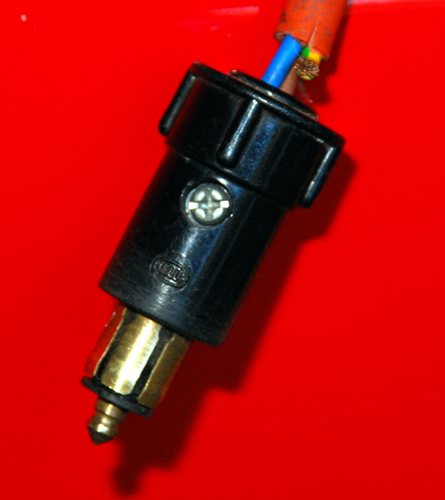
Hella / DIN plug
Remember that if your battery has been heavily discharged, the battery charging current will be restricted to about 2 amps by the current-limiting resistance built into the cigar lighter socket – a full charge will therefore take some time. In such cases it is preferable to connect the charger directly to the battery, or via the jump start connectors. Alternatively, a socket connected directly to the battery via a fuse is always a good idea.
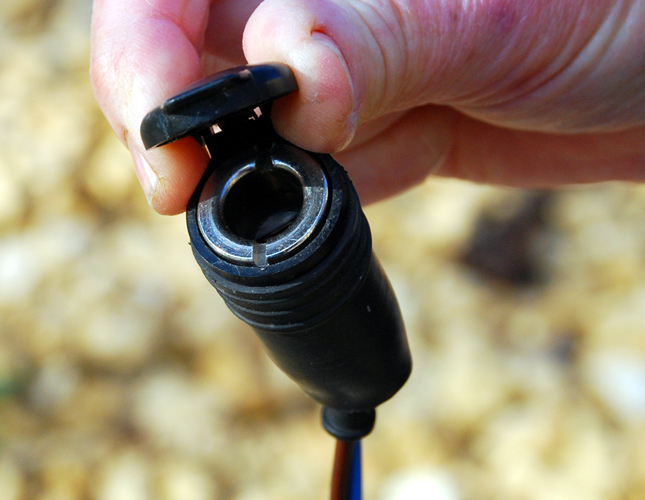
Hella / DIN power socket
Switching on the lights for a couple of hours every week, followed by recharging, will help to prolong the life of the battery. Alternatively, use the charger every week or so, the gradual self-discharge providing a similarly beneficial cycling effect.
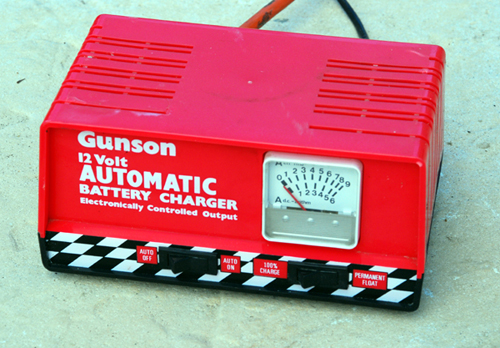
Typical constant voltage (‘automatic’) charger
Owners of ABS-equipped cars should remember that the ABS memory will record a power supply problem when the battery voltage falls below 12.6 volts. If the battery has been neglected, do not attempt to start before charging it, as a visit to your BMW dealer to reset the system’s fault memory will cost more than a decent battery charger.
No Electricity?
If your car will not be used for a long period and your garage lacks electricity, there is little option but to remove the battery for the duration, but the Service Indicator batteries will still need to be charged.
A good answer to this problem is to insulate the battery positive terminal, and connect an 18 ampère-hour motorcycle battery (with a 3 amp fuse in one cable) via the cigar lighter socket. Replace the battery with a freshly-charged one every week or two. This will also enable the alarm system to be kept active.
Wear And Tear
During normal use a certain amount of the plate material will become detached, and fall into the base of the cell. This means that the effective area of the plates is reduced, and – like water flowing through a flattened pipe – the resistance to flow is increased. This is known as increased internal resistance, the classic symptom being that while low current demands such as the lights will operate normally, operation at high current – the starter motor – causes the voltage to collapse.
The usual reaction is to charge the battery, after which voltage and specific gravity tests will often reveal an apparently healthy battery. A battery specialist would test the battery by connecting a low resistance across the terminals while measuring the voltage under load, but an alternative method is available.

Checking the specific gravity with a hydrometer
Remove all the filler plugs, then while wearing eye protection and keeping a safe distance, observe the electrolyte levels while trying to start. Passing current through any resistance will generate heat, and in this case the heat will be sufficient to quickly boil the electrolyte in the affected cell. This test is absolutely conclusive, and of course the answer is to replace the battery.
Sudden Death
Loss of conductive paste from the plates – in larger quantities – can cause a sudden battery failure in two ways.
If sufficient paste falls to the bottom of the cell without touching the plates, the cell will become open circuited, and there will no longer be a current path, resulting in the battery voltage falling to zero.
It is worth remembering that modern low-maintenance batteries develop this problem very quickly, often at the end of an apparently normal run, after which starting will become impossible.
If the paste manages to bridge the negative and positive plates in a cell, it will become short circuited, so connecting the adjacent cells together. Starter current passing through the paste will heat and fuse it together, resulting in the loss of that cell.
A short circuited cell can be easily diagnosed, as the battery voltage will be reduced by about 2 volts. The alternator output will then be much higher than the battery voltage, so a higher current will be passed through the healthy cells, causing increased ‘gassing’ and electrolyte loss in them. The increased load on the alternator will also reduce the overall system voltage, with symptoms such as poor lights and slow wipers.
Best Practice
Obviously, the worst treatment a battery can receive is being left to stagnate in a much-loved car which is seldom used. The answer is to persuade the battery that it is being used, by connecting it to a constant-voltage charger via the cigar lighter socket or a separate power socket, such as the Hella DIN-type. These are in common use from BMW motorcycles to John Deere tractors, and are readily available from many auto-electrical suppliers. The use of a socket directly connected to the battery is particularly useful on cars with ‘Single-wire’ or CANBUS electrical system.
This practice is usual in industrial and marine installations, and will not upset your car’s electronic gremlins, who will simply assume that the alternator is charging the battery. Use the lights every week to partially discharge the battery, such cycling helping to reduce any long-term capacity loss.
Suitable chargers are easily found, such as the Gunsons ‘Automatic’ type, which is available from German & Swedish branches for about £25.
Do not regard charging as an occasional treat for your battery, but as a routine procedure.
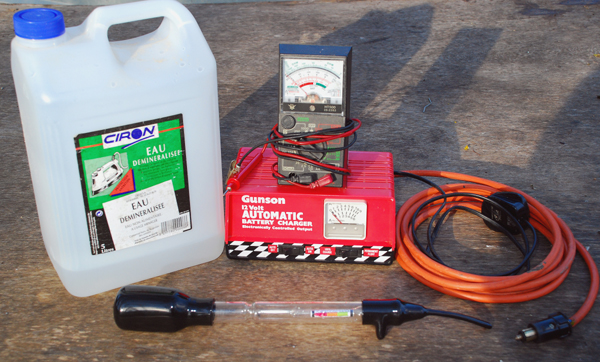
Battery maintenance equipment
If your car is in regular use connect it whenever it is in its garage. Apart from the advantage of starting a cold, dark, winter day with a fully-charged battery, you will also extend its useful life.
I have been charging my cars and motorcycles in this manner for over thirty years without any problems, finding that battery life is at least doubled. As an example, my Z3 has just celebrated its tenth birthday and is still using the original battery, which remains like new, giving specific gravities of 1275 to 1300, and maintaining 14 volts even after being off-charge for 24 hours.
Benefits
A well-cared for battery does not place a heavy charging load on the alternator, which is then better able to maintain its voltage when under load. This enables the entire electrical system to operate at full efficiency, which is particularly noticeable in terms of lights.
For example, many Z3 owners claim their headlights to be dangerously poor, and buy HID replacements rather than looking at the basic problem of low voltage. With its battery in top condition, however, the Red Zed’s headlamps are really excellent, their Philips Blue Vision bulbs providing long range beams of brilliant white light.
Modern engines are very dependant on a good electrical supply, and several owners have noticed a sudden improvement in performance after fitting a new battery. For example, low voltage will affect the operation of the solenoid valves in the VANOS system, with the result that the engine may seem a little ‘off colour’ for a while after the first start of the day, until the battery voltage has been raised by charging.
Your car’s battery is the heart of its electrical system, and is worth taking care of – look after it, and it will look after you.
Even those who keep their cars in top condition often ignore their battery until it dies. This failure is usually regarded with surprise, and accepted as being ‘One of those things,’ but at £60 to £80 a time it is an expensive folly.

Typical BMW Battery – Z3
Normal Maintenance
If your battery is not a sealed zero-maintenance type, it needs a check on the cell levels at least twice a year, and topping up with de-mineralised water – as is used in steam irons etc. This compensates for loss of the water in the dilute sulphuric acid electrolyte being turned into bubbles of oxygen and hydrogen by the charging current, a process known as ‘gassing.’
During winter, do not top up your battery and leave it, as the water will lie on top of the denser electrolyte, and may freeze. Top up before driving, when normal charging will mix the water and acid.

Normal maintenance equipment in action
Even low-maintenance batteries, in which the use of lead-calcium plates promotes less ‘gassing’ and loss of water from the electrolyte, still require an occasional check. A strip of adhesive tape across the plugs – even if it has a BMW logo – does not denote a ‘sealed’ battery, being simply a sign that the battery has not been checked since it was built.
Measure the battery voltage some hours after charging, or a decent run, when 12.5 to 13 volts should be found. If in doubt, check your meter against a known good instrument, and do not regard digital meters as being inherently accurate. Your car’s alternator should maintain 13.5 to 14.4 volts with a fully-charged battery.
Also take hydrometer readings of each cell. With a fully-charged battery these should read between 1275 and 1300 (the specific gravity, or density, when compared to distilled water at 1000). If your battery is under the bonnet, the readings will be lower when hot, but a single lower reading indicates a dying cell. Suitable hydrometers are readily available from Halfords etc. and are also handy for topping up the cells.
Remember that the dilute sulphuric acid used in batteries is corrosive, so try not to drip it on clothing or bodywork, as before long it will eat through. Needless to say, contact with skin or eyes is to be avoided. Treat any spillages with a strong bicarbonate of soda solution, and rinse copiously.
The more modern batteries really are sealed, and use a chemical process to convert the gases formed during charging back into dilute sulphuric acid again. They – as with any other battery – only ask to be protected from extremes of heat and cold, or fully discharged.
Occasionally remove and clean the battery terminals, lightly coating them with Vaseline before reassembly. Do not forget the engine earth strap, which is usually bolted to the aluminium of the offside engine mounting. Corroded aluminium makes a wonderful insulator, and in some circumstances a failed engine earth can destroy the engine’s electronics. In many cases the earthing lugs are crimped around their flexible copper straps, which can set up considerable resistance once corrosion has taken place. Always replace them with the soldered type.
Lack Of Use
Stagnation, and the associated sulphation of the plates, kills more lead-acid batteries than anything else. Seldom-used cars are of course most at risk.
If you intend to lay the car up for the winter, top up the cells well before driving for the last time, as this will charge the battery and help the water and acid to mix – remember that unmixed water will freeze before the acid.
Do not just leave your car standing during winter, as afterwards you may find the battery to be dead due to the normal self-discharge and the current drain through the alternator diodes, charging the Service Indicator batteries, maintaining the memory of the radio etc. Some after-market electronic equipment can increase this level appreciably, as can a faulty boot light switch.
This current drain – typically 30 mA – will reduce battery capacity by about 20 ampère-hours per month. At 0°C a battery will lose half of its capacity at 20°C, so during the coldest weather the battery may be flat after two months. Deep discharges will ruin low-maintenance batteries, such damage being excluded from guarantee claims.
Remember that if the vehicle battery is flattened, the stand-by batteries on the Service Indicator board will discharge. If flattened, these nickel-cadmium batteries require a low initial charge rate, and will be over-charged by connection to a freshly-charged vehicle battery. The result will be an early end to their life, and possibly expensive damage to the SI board.
Ideally the battery should be connected to a constant-voltage charger, and left on a continuous float charge just below the level where ‘gassing’ takes place. Under such conditions the battery will not require to be disconnected, or to have its filler plugs removed. Ideally use a dedicated power socket, such as the DIN-standard type manufactured by Hella, but for regular low-current ‘Float’ charging the cigar lighter will suffice.

Hella / DIN plug
Remember that if your battery has been heavily discharged, the battery charging current will be restricted to about 2 amps by the current-limiting resistance built into the cigar lighter socket – a full charge will therefore take some time. In such cases it is preferable to connect the charger directly to the battery, or via the jump start connectors. Alternatively, a socket connected directly to the battery via a fuse is always a good idea.

Hella / DIN power socket
Switching on the lights for a couple of hours every week, followed by recharging, will help to prolong the life of the battery. Alternatively, use the charger every week or so, the gradual self-discharge providing a similarly beneficial cycling effect.

Typical constant voltage (‘automatic’) charger
Owners of ABS-equipped cars should remember that the ABS memory will record a power supply problem when the battery voltage falls below 12.6 volts. If the battery has been neglected, do not attempt to start before charging it, as a visit to your BMW dealer to reset the system’s fault memory will cost more than a decent battery charger.
No Electricity?
If your car will not be used for a long period and your garage lacks electricity, there is little option but to remove the battery for the duration, but the Service Indicator batteries will still need to be charged.
A good answer to this problem is to insulate the battery positive terminal, and connect an 18 ampère-hour motorcycle battery (with a 3 amp fuse in one cable) via the cigar lighter socket. Replace the battery with a freshly-charged one every week or two. This will also enable the alarm system to be kept active.
Wear And Tear
During normal use a certain amount of the plate material will become detached, and fall into the base of the cell. This means that the effective area of the plates is reduced, and – like water flowing through a flattened pipe – the resistance to flow is increased. This is known as increased internal resistance, the classic symptom being that while low current demands such as the lights will operate normally, operation at high current – the starter motor – causes the voltage to collapse.
The usual reaction is to charge the battery, after which voltage and specific gravity tests will often reveal an apparently healthy battery. A battery specialist would test the battery by connecting a low resistance across the terminals while measuring the voltage under load, but an alternative method is available.

Checking the specific gravity with a hydrometer
Remove all the filler plugs, then while wearing eye protection and keeping a safe distance, observe the electrolyte levels while trying to start. Passing current through any resistance will generate heat, and in this case the heat will be sufficient to quickly boil the electrolyte in the affected cell. This test is absolutely conclusive, and of course the answer is to replace the battery.
Sudden Death
Loss of conductive paste from the plates – in larger quantities – can cause a sudden battery failure in two ways.
If sufficient paste falls to the bottom of the cell without touching the plates, the cell will become open circuited, and there will no longer be a current path, resulting in the battery voltage falling to zero.
It is worth remembering that modern low-maintenance batteries develop this problem very quickly, often at the end of an apparently normal run, after which starting will become impossible.
If the paste manages to bridge the negative and positive plates in a cell, it will become short circuited, so connecting the adjacent cells together. Starter current passing through the paste will heat and fuse it together, resulting in the loss of that cell.
A short circuited cell can be easily diagnosed, as the battery voltage will be reduced by about 2 volts. The alternator output will then be much higher than the battery voltage, so a higher current will be passed through the healthy cells, causing increased ‘gassing’ and electrolyte loss in them. The increased load on the alternator will also reduce the overall system voltage, with symptoms such as poor lights and slow wipers.
Best Practice
Obviously, the worst treatment a battery can receive is being left to stagnate in a much-loved car which is seldom used. The answer is to persuade the battery that it is being used, by connecting it to a constant-voltage charger via the cigar lighter socket or a separate power socket, such as the Hella DIN-type. These are in common use from BMW motorcycles to John Deere tractors, and are readily available from many auto-electrical suppliers. The use of a socket directly connected to the battery is particularly useful on cars with ‘Single-wire’ or CANBUS electrical system.
This practice is usual in industrial and marine installations, and will not upset your car’s electronic gremlins, who will simply assume that the alternator is charging the battery. Use the lights every week to partially discharge the battery, such cycling helping to reduce any long-term capacity loss.
Suitable chargers are easily found, such as the Gunsons ‘Automatic’ type, which is available from German & Swedish branches for about £25.
Do not regard charging as an occasional treat for your battery, but as a routine procedure.

Battery maintenance equipment
If your car is in regular use connect it whenever it is in its garage. Apart from the advantage of starting a cold, dark, winter day with a fully-charged battery, you will also extend its useful life.
I have been charging my cars and motorcycles in this manner for over thirty years without any problems, finding that battery life is at least doubled. As an example, my Z3 has just celebrated its tenth birthday and is still using the original battery, which remains like new, giving specific gravities of 1275 to 1300, and maintaining 14 volts even after being off-charge for 24 hours.
Benefits
A well-cared for battery does not place a heavy charging load on the alternator, which is then better able to maintain its voltage when under load. This enables the entire electrical system to operate at full efficiency, which is particularly noticeable in terms of lights.
For example, many Z3 owners claim their headlights to be dangerously poor, and buy HID replacements rather than looking at the basic problem of low voltage. With its battery in top condition, however, the Red Zed’s headlamps are really excellent, their Philips Blue Vision bulbs providing long range beams of brilliant white light.
Modern engines are very dependant on a good electrical supply, and several owners have noticed a sudden improvement in performance after fitting a new battery. For example, low voltage will affect the operation of the solenoid valves in the VANOS system, with the result that the engine may seem a little ‘off colour’ for a while after the first start of the day, until the battery voltage has been raised by charging.
Your car’s battery is the heart of its electrical system, and is worth taking care of – look after it, and it will look after you.
